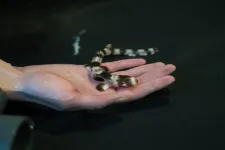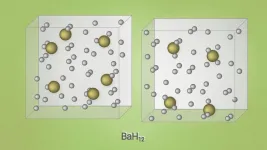(Press-News.org) Researchers at Karolinska Institutet in Sweden have developed, in collaboration with researchers in Germany and the U.S., new small antibodies, also known as nanobodies, which prevent the SARS-CoV-2 coronavirus from entering human cells. The research study, published in Science, shows that a combined nanobody had a particularly good effect - even if the virus mutated. According to the researchers, the nanobodies have the potential to be developed into a treatment for COVID-19.
Specific proteins, spike proteins, on the surface of the SARS-CoV-2 coronavirus help the virus infect host cells. Therefore, antibodies that block the spike proteins and prevent them from binding to the cell can be a way to stop infection.
From the perspective of potential therapeutic interventions, small fragments of antibodies, referred to as single-domain antibodies (sdAb) or nanobodies, may be a better alternative than regular antibodies. That is because nanobodies are significantly smaller. They are therefore able to bind to the virus in more places than regular antibodies. Nanobodies also have greater stability and are easier to produce cost-effectively on a large scale.
Researchers at Karolinska Institutet are now publishing, in collaboration with researchers at the University of Bonn in Germany and the Scripps Research Institute in California, a study describing new nanobodies against SARS-CoV-2 infection.
"What is uniquely special here is that we have stitched together nanobodies that bind to two different places on the spike protein of the virus," explains Martin Hällberg, researcher at the Department of Cell and Molecular Biology at Karolinska Institutet, and one of the research study's corresponding authors.
"This combination variant binds better than individual nanobodies and is exceptionally effective in blocking the virus' ability to spread between human cells in cell culture."
Additionally, the combined nano-antibodies worked even when tested on a virus variant that mutates extremely quickly.
"This means that the risk is very small that the virus would become resistant to these combined nanobodies," notes Martin Hällberg.
To generate the nanobodies, alpacas and llamas - animals whose immune systems naturally produce both antibodies and nanobodies - were vaccinated with the spike protein of the coronavirus. Among the nanobodies generated by the animals, the researchers selected the best binders. Among these, four were identified as showing an exceptional ability to block the virus' ability to spread among human cultured cells.
The research group at Karolinska Institutet then used electron cryomicroscopy (cryo-EM) to study in detail how the various nanobodies bind to the virus' spike protein. Thanks to their structural knowledge, they were able to propose suitable protein links to bind different nanobodies together into combinations relevant for research, as well as provide a possible explanation for the mechanism of how the antibodies neutralise the virus.
"My 'favourite' is the nanobody from the llama," Martin Hällberg says. "It binds directly over the surface where the virus binds the host cell receptor ACE2, and the nanobody also shares a large majority of the amino acids critical for binding with ACE2. What this means is that the virus will have an extremely difficult time mutating extensively on that surface and at the same time being able to bind ACE2. A variant where this llama antibody is linked to one of the antibodies from alpaca was a fox trap that the virus never managed to get out of in our experiments."
The researchers now hope that their nanobodies will be able to be developed into a drug treatment as a complement to a vaccination against COVID-19.
"It possibly could be used clinically for those already ill, or for prevention for individuals who for one reason or another cannot be vaccinated, or who have a weakened immune system, and therefore may not form a sufficiently strong immune response after a vaccination," explains Martin Hällberg.
Dioscure Therapeutics, a spin-off company from the University of Bonn, will be conducting further testing of the nanobodies in clinical trials. The researchers at Karolinska Institutet will make attempts to improve the binding further by changing individual building blocks in the nanobodies.
The research was funded by the Swedish Research Council and the Knut and Alice Wallenberg Foundation, as well as by research funders in Germany and the U.S.
INFORMATION:
The researchers behind the research study have filed patent applications associated with the nanobodies. Two of the researchers are also co-founders and shareholders in the company Dioscure Therapeutics, which will be commercialising the antibodies. Two of the researchers have connections with each other, as co-founders, consultants and shareholders in the IFM Therapeutics company.
Publication: "Structure-guided multivalent nanobodies block SARS-CoV-2 infection and suppress mutational escape", Paul-Albert König, Hrishikesh Das, Hejun Liu, Beate M. Kümmerer, Florian N. Gohr, Lea-Marie Jenster, Yonas M. Tesfamariam, Lisa D.J. Schiffelers, Miki Uchima, Jennifer D. Wuerth, Karl Gatterdam, Natalia Ruetalo, Maria H. Christensen, Caroline I. Fandrey, Sabine Normann, Steffen Pritzl, Jan M. P. Tödtmann, Leo Hanke, Jannik Boos, Meng Yuan, Xueyong Zhu, Jonathan Leo Schmid-Burgk, Hiroki Kato, Michael Schindler, Ian A. Wilson, Matthias Geyer, Kerstin U. Ludwig, B. Martin Hällberg, Nicholas C. Wu and Florian I. Schmidt. Science, online January 12, 2021, doi: 10.1126/science.abe6230.
What will the SARS-CoV-2 outbreak look like ten years from now as it passes from pandemic to endemic, maintained at a constant baseline level in populations without being fueled by outside infections? Data from four endemic human coronaviruses, which circulate globally and cause only mild symptoms, may hold some answers, say Jennie Lavine and colleagues. Their analysis of the immunological and epidemiological data for these viruses helped them develop a model to predict the trajectory of SARS-CoV-2 as it becomes endemic. Most importantly, the authors say, their model incorporates distinct components of immunological protection--susceptibility to reinfection, weakening of the disease after reinfection, and transmissibility of the virus after reinfection--that each wane differently. Lavine ...
An immunization strategy tested in mice protects against infection from SARS-CoV-2, as well as from potentially emerging animal coronaviruses, researchers say. The approach could be "used as described or easily adapted" to provide defense against newly discovered zoonotic coronaviruses. In the last 20 years, three betacoronaviruses have caused devastating disease in humans. The global pandemic caused by the latest such virus, SARS-CoV-2, highlights the need to protect against other strains that could present a threat to humans, possibly through a pan-coronavirus vaccine. To support related efforts, ...
Thanks to major progress in the understanding and management of rare congenital diseases and syndromes, many patients with these rare disorders are now living longer lives. With this progress it has become apparent that many non-skeletal rare diseases have an impact on bone mass, bone quality and/or bone metabolism, with potentially severe repercussions for quality of life in adults.
The new paper 'Bone fragility in patients affected by congenital diseases non skeletal in origin', published in Orphanet Journal of Rare Diseases by the International Osteoporosis Foundation (IOF) Skeletal Rare Diseases Working Group (SRDWG), provides ...
Most people experience turbulence primarily from the experience of flying in an airplane. However, turbulence is a key feature of nature and is found everywhere, from rivers to galaxies.
Turbulent-like dynamics are difficult to capture in a still image. However, Leonardo da Vinci did everything possible to identify the underlying order of the phenomenon, which he observed in eddy currents forming randomly in water. In fact, he was fascinated by trying to understand and describe the generating principles governing such complicated dynamics. This is so much ...
Scientists are combining artificial intelligence and advanced computer technology with biological know how to identify insects with supernatural speed. This opens up new possibilities for describing unknown species and for tracking the life of insects across space and time
Insects are the most diverse group of animals on Earth and only a small fraction of these have been found and formally described. In fact, there are so many species that discovering all of them in the near future is unlikely.
This enormous diversity among insects also means that they have very different life histories and roles in the ecosystems.
For ...
A new study conducted at the New England Aquarium finds that as climate change causes the ocean to warm, baby sharks are born smaller, exhausted, undernourished, and into environments that are already difficult for them to survive in.
In a recently published paper in the journal Scientific Reports, lead author Carolyn Wheeler, a Ph.D. candidate at the University of Massachusetts Boston and at the ARC Centre of Excellence for Coral Reef Studies at James Cook University, examined the effects of increased temperatures on the growth, development and physiological performance of epaulette ...
It's been more than a year since the first cases were identified in China, yet the exact origins of the COVID-19 pandemic remain a mystery. Though strong evidence suggests that the responsible coronavirus originated in bats, how and when it crossed from wildlife into humans is unknown.
In a study published online Jan.12 in the journal mBio, an international team of 15 biologists say this lack of clarity has exposed a glaring weakness in the current approach to pandemic surveillance and response worldwide.
In most recent studies of animal-borne pathogens with the potential to spread to humans, known as zoonotic pathogens, physical specimens of suspected wildlife ...
Exercising regularly is one of the best defences against metabolic diseases, such as obesity and diabetes - but why? It's a question that scientists are still struggling to answer. While exercising changes the molecular behaviour of muscles, it's not well understood how these molecular changes improve metabolic health.
Scientists at the University of Copenhagen have now developed a new technology that allows researchers to study muscle biology on a more detailed level - and hopefully find some new answers. They extracted 'fast' and 'slow' twitch muscle fibers from freeze-dried muscle samples that were taken before and after 12 weeks of cycling exercise training. Their comprehensive analysis of the protein expression of the fibers provides new evidence that the ...
BOSTON -- By mid-November, the Centers for Disease Control and Prevention had reported that 218,439 health care workers in the U.S. had been infected with COVID-19 -- a likely underestimate due to incomplete data from states. About 3% to 4% of health care personnel who recover from coronavirus infection are expected to become "COVID long-haulers" as they cope with debilitating symptoms 12 to 18 months after the acute stage of the infection clears.
"As COVID-19 surges again, hospitals are facing a shortage of skilled frontline providers who can meet the relentless demands of caring for these patients," says Zeina N. Chemali, MD, MPH, a psychiatrist and neurologist at Massachusetts ...
A group of scientists from Russia, China, and the United States predicted and then experimentally obtained barium superhydrides' new unusual superconductors. The study was published in Nature Communications.
Chemists and physicists have been hunting down room-temperature superconductors since the first half of the 20th century. Initially, high hopes were placed on metallic hydrogen, but solid metallic hydrogen can become superconducting only at extremely high pressures of several million atmospheres, as it later transpired. Chemists then tried adding other elements to hydrogen in the hope of attaining superconductivity by stabilizing the metallic state under less challenging conditions. ...


